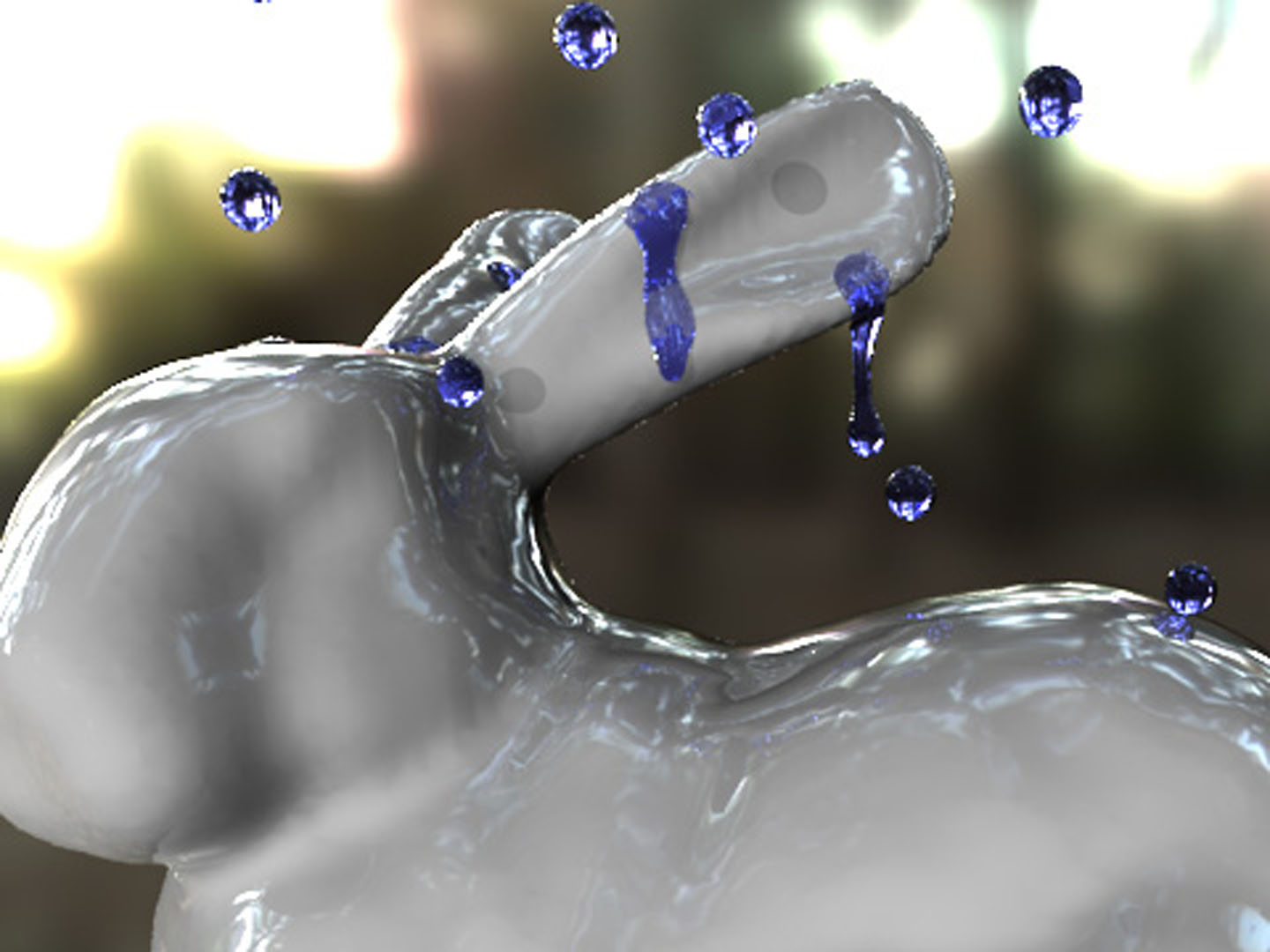“Water drops on surfaces” by Wang, Mucha and Turk
Conference:
Type(s):
Title:
- Water drops on surfaces
Presenter(s)/Author(s):
Abstract:
We present a physically-based method to enforce contact angles at the intersection of fluid free surfaces and solid objects, allowing us to simulate a variety of small-scale fluid phenomena including water drops on surfaces. The heart of this technique is a virtual surface method, which modifies the level set distance field representing the fluid surface in order to maintain an appropriate contact angle. The surface tension that is calculated on the contact line between the solid surface and liquid surface can then capture all interfacial tensions, including liquid-solid, liquid-air and solid-air tensions. We use a simple dynamic contact angle model to select contact angles according to the solid material property, water history, and the fluid front’s motion. Our algorithm robustly and accurately treats various drop shape deformations, and handles both flat and curved solid surfaces. Our results show that our algorithm is capable of realistically simulating several small-scale liquid phenomena such as beading and flattened drops, stretched and separating drops, suspended drops on curved surfaces, and capillary action.
References:
1. Bussmann, M., Mostaghimi, J., and Chandra, S. 1999. On a three-dimensional volume tracking model of droplet impact. Phys. Fluids 11, 1406.Google ScholarCross Ref
2. De Gennes, P. 1985. Wetting: Statics and dynamics. Rev. Mod. Phys. 57, 3, 827–863.Google ScholarCross Ref
3. Dorsey, J., Pedersen, H. K., and Hanrahan, P. 1996. Flow and changes in appearance. In Proc. of ACM SIGGRAPH ’96, 411–420. Google ScholarDigital Library
4. Enright, D., Marschner, S., and Fedkiw, R. 2002. Animation and rendering of complex water surfaces. In Proc. of ACM SIGGRAPH ’02, 736–744. Google ScholarDigital Library
5. Enright, D., Nguyen, D., Gibou, F., and Fedkiw, R. 2003. Using the particle level set method and a second order accurate pressure boundary condition for free surface flows. In Proceeding of the 4th ASME-JSME Joint Fluids Eng. Conf, FEDSM2003-45144, 1–6.Google Scholar
6. Feng, Z. G., Domaszewski, M., Montavon, G., and Coddet, C. 2002. Finite element analysis of effect of substrate surface roughtness on liquid droplet impact and flattening process. Journal of Thermal Spray Technology 11, 1, 62–68.Google ScholarCross Ref
7. Foster, N., and Fedkiw, R. 2001. Practical animation of liquids. In Proc. of ACM SIGGRAPH ’01, 23–30. Google ScholarDigital Library
8. Foster, N., and Metaxas, D. 1996. Realistic animation of liquids. Graph. Models Image Process. 58, 5, 471–483. Google ScholarDigital Library
9. Fournier, P., Habibi, A., and Poulin, P. 1998. Simulating the flow of liquid droplets. In Graphics Interface, 133–142.Google Scholar
10. Healy, W. M. 1999. Modeling the Impact of a Liquid droplet on a Solid Surface. PhD thesis, Georgia Institute of Technology.Google Scholar
11. Jiang, G.-S., and Peng, D. 2000. Weighted eno schemes for hamilton jacobi equations. SIAM J. Sci. Comput. 21, 2126–2143. Google ScholarDigital Library
12. Kaneda, K., Kagawa, T., and Yamashita, H. 1993. Animation of water droplets on a glass plate. In Proc. Computer Animation ’93, 177–189.Google Scholar
13. Kaneda, K., Zuyama, Y., Yamashita, H., and Nishita, T. 1996. Animation of water droplet flow on curved surfaces. In Proc. PACIFIC GRAPHICS ’96, 50–65.Google Scholar
14. Kaneda, K., Ikeda, S., and Yamashita, H. 1999. Animation of water droplets moving down a surface. The Journal of Visualization and Computer Animation 10, 1, 15–26.Google ScholarCross Ref
15. Korlie, M. 1997. Particle modeling of liquid drop formation on a solid surface in 3-d. Compute. and Math. with Appl. 33, 9, 97–114.Google ScholarCross Ref
16. Losasso, F., Gibou, F., and Fedkiw, R. 2004. Simulating water and smoke with an octree data structure. In Proc. of ACM SIGGRAPH ’04, vol. 23, 457–462. Google ScholarDigital Library
17. Osher, S., and Fedkiw, R. 2002. Level Set Methods and Dynamic Implicit Surfaces. Springer-Verlag.Google Scholar
18. Pharr, M., and Humphreys, G. 2004. Physically Based Rendering: From Theory to Implementation. Morgan Kaufmann. Google ScholarDigital Library
19. Renardy, M., Renardy, Y., and Li, J. 2001. Numerical simulation of moving contact line problems using a volume-of-fluid method. Journal of Computational Physics 171, 243–263. Google ScholarDigital Library
20. Schwartz, L. W., and Garoff, S. 1985. Contact angle hyesteresis on heterogeneous surfaces. Langmuir 1, 2, 219–230.Google ScholarCross Ref
21. Sethian, J. 1996. A fast marching level set method for monotonically advancing fronts. In Proc. Natl. Acad. Sci., vol. 93, 1591–1595.Google ScholarCross Ref
22. Stam, J. 1999. Stable fluids. In Proc. of ACM SIGGRAPH ’99, 121–128. Google ScholarDigital Library
23. Sussman, M., and Uto, S. 1998. A computational study of the spreading. of oil underneath a sheet of ice. CAM Report 98–32, University of California, Dept. of Math, Los Angeles.Google Scholar
24. Tong, R., Kaneda, K., and Yamashita, H. 2002. A volume-preserving approach for modeling and animating water flows generated by metaballs. The Visual Computer 18, 8, 469–480.Google ScholarCross Ref
25. Tsitsiklis, J. 1995. Efficient algorithms for globally optimal trajectories. IEEE Trans. on Automatic Control 40, 1528–1538.Google ScholarCross Ref
26. Yu, Y.-J., Jung, H.-Y., and Cho, H.-G. 1999. A new water droplet model using metaball in the gravitational field. Computer and Graphics 23, 213–222.Google ScholarCross Ref
27. Zhao, H.-K., Merriman, B., Osher, S., and Wang, L. 1998. Capturing the behavior of bubbles and drops using the variational level set method. Computational Physics 143, 495–518. Google ScholarDigital Library





